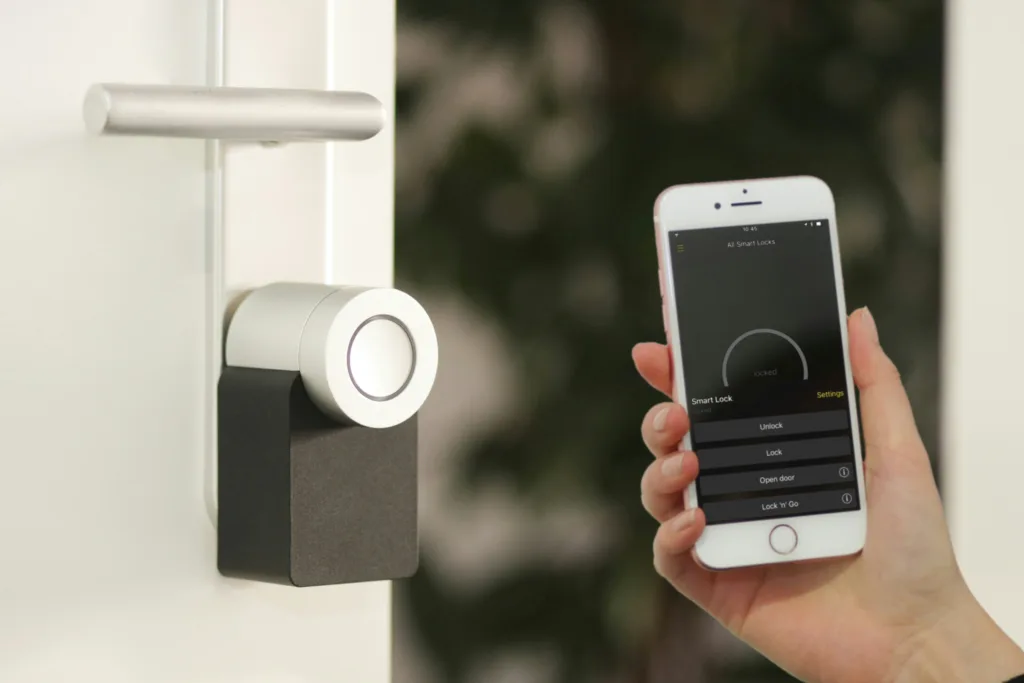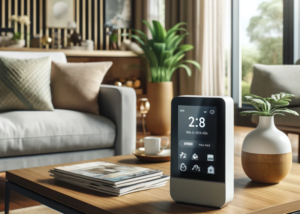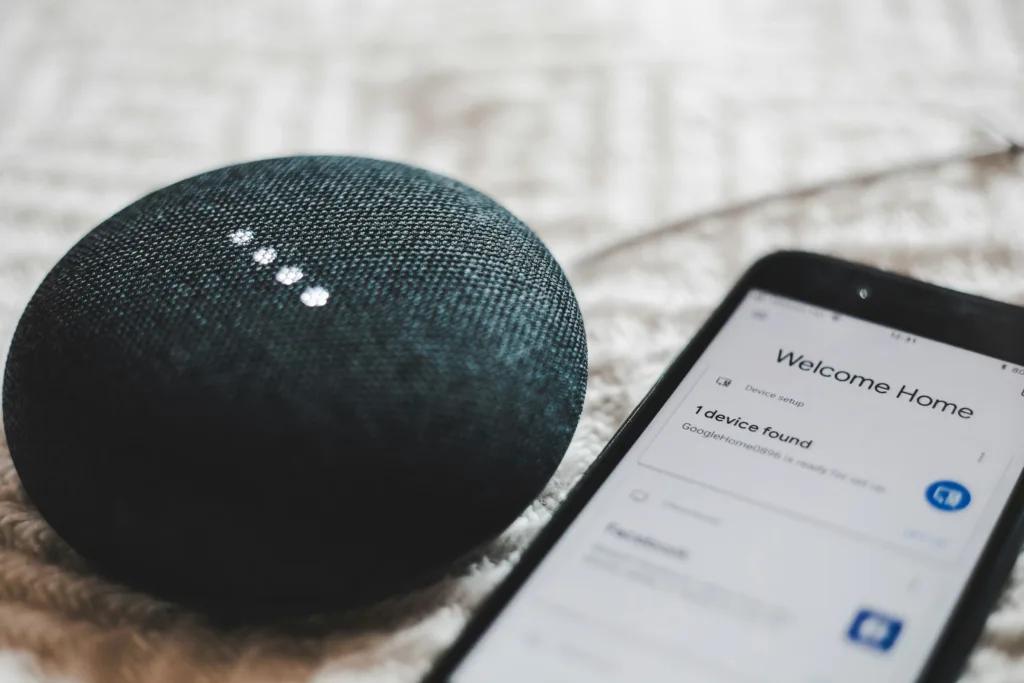Home is the place where you want to feel comfortable and safe. Just imagine: you come home after a long day at work and everything is adjusted to your preferences in only one minute. And when I say everything I mean everything! Temperature, lightning, music, etc. Moreover you can easily do it from your smartphone. With smart home solutions, achieving a safe, efficient, and personalized living space has never been easier. Isn’t it great?

What is a Smart Home?
A smart home is a residence equipped with internet-connected devices that allow for the remote monitoring and management of appliances and systems. These devices are part of the Internet of Things (IoT), a network of physical objects that gather and share electronic information. A smart home system connects these devices, enabling homeowners to control them via a single app or a central hub, enhancing convenience, security, and energy efficiency.
A smart home is a residence where modern technology integrates seamlessly to create an environment that anticipates and responds to the needs of its inhabitants. Through the use of sensors, connected devices, and intelligent algorithms, smart homes can adjust settings automatically, provide real-time alerts, and offer remote access to household operations.
A smart home utilizes cutting-edge technology to transform a traditional living space into a responsive, interactive environment. By integrating various devices and systems via the internet, a smart home can automate routine tasks, enhance security measures, and improve energy efficiency, all of which can be controlled remotely by the homeowner.
A smart home is a residence equipped with internet-connected devices that allow for the remote monitoring and management of appliances and systems such
Key Components of a Smart Home
Smart Home System
The smart home system acts as the hub of a smart home, gathering unique information from each smart device or appliance and enabling centralized control. These systems can be wall-mounted units or software accessible via the internet, such as Amazon Echo, Google Home, or Samsung SmartThings Hub. Choosing the right hub is crucial for ensuring that all devices can communicate and work together seamlessly.
Connectivity and Networking
A robust and reliable internet connection is essential for a smart home, as all devices communicate through Wi-Fi or other wireless protocols like Zigbee or Z-Wave. Quality routers and mesh systems ensure stable and far-reaching connections. This connectivity backbone is critical for the smooth operation of smart home devices.
Benefits of a Smart Home
Energy Efficiency
Smart homes allow for greater control over energy use, automating tasks like adjusting temperature, turning off lights, and managing irrigation. Smart thermostats and plugs can optimize energy consumption, reducing utility bills and conserving resources. According to the U.S. Department of Energy, smart thermostats can save homeowners up to 10% on heating and cooling bills annually.
Enhanced Security
Smart security systems, including smart locks, doorbell cameras, and motion sensors, provide real-time alerts and remote monitoring, ensuring peace of mind even when homeowners are away. The global smart home security market is projected to reach $74.75 billion by 2023, highlighting the growing importance of security in smart home technology.
Convenience and Comfort
Smart homes offer unparalleled convenience, allowing homeowners to control various aspects of their home with voice commands or smartphone apps. Automated routines and schedules can adjust lighting, temperature, and other settings based on daily activities. This level of convenience transforms how we interact with our living spaces, making daily tasks easier and more efficient.
Health and Wellness Monitoring
Connected health monitors and wearable devices can transmit data to smart home systems, allowing homeowners to track their well-being and receive personalized insights. The global smart health monitoring devices market size was valued at $25.4 billion in 2020 and is expected to grow at a compound annual growth rate (CAGR) of 27.5% from 2021 to 2028, reflecting the increasing integration of health and wellness features in smart homes.
How to Build a Smart Home
Define Your Goals
Determine what you want to achieve with your smart home, whether it’s simplifying daily tasks, reducing energy bills, or enhancing security. Identifying clear goals helps in choosing the right devices and systems that meet your specific needs.
Plan and Budget
Start with a clear plan and budget. Begin with basic devices like smart plugs, lights, and thermostats, and expand over time. Research different brands to find quality products that fit your needs. For instance, starting with a smart thermostat and gradually adding smart lighting and security systems can spread out costs while building a comprehensive smart home system.
Ensure Compatibility
Choose a primary smart home system, such as Amazon Alexa, Google Home, or Apple HomeKit, and ensure all devices are compatible with it. This ensures a cohesive and integrated smart home experience. Compatibility is key to avoiding future issues where devices cannot communicate effectively, leading to a fragmented system.
Installation
Decide between DIY installation or professional help. DIY can be more cost-effective but may require technical know-how. Professional installation offers a hassle-free experience and ensures all devices work seamlessly. Many smart home systems come with user-friendly apps and guides, but complex setups, particularly involving security systems or extensive home automation, might benefit from professional expertise.
Popular Smart Home Devices
Smart Speakers and Voice Assistants
Devices like Amazon Echo, Google Nest Speakers, and Apple’s HomePod act as personal assistants, answering questions, setting reminders, and controlling other smart devices. These devices have become central to the smart home experience, providing an intuitive interface for managing various smart devices.
Smart Lighting
Smart bulbs and switches offer remote control, dimming, color changing, and scheduling. Brands like Philips Hue and LIFX are popular choices. Smart lighting can be customized to create different moods and settings, enhancing both the functionality and ambiance of living spaces.
Smart Thermostats
Devices like Nest Thermostat and Ecobee adjust heating and cooling based on homeowner habits, ensuring comfort and energy efficiency. These thermostats can learn your schedule and preferences, automatically optimizing settings to save energy and maintain comfort.
Smart Security Systems
Smart cameras, motion detectors, and alarms provide real-time alerts and remote monitoring. Popular choices include SimpliSafe and ADT Pulse. These systems can be integrated with other smart home devices to create comprehensive security solutions that are easy to manage and monitor.
Smart Appliances
Smart refrigerators, ovens, and washing machines offer remote access and control, alerting users to relevant information and optimizing energy use. These appliances not only add convenience but also contribute to a more efficient household by automating routine tasks.
Challenges and Considerations
Security and Privacy
Smart homes introduce security challenges, as IoT devices can be vulnerable to hacking. Homeowners should secure their network with strong passwords and encryption and be vigilant about data privacy. A comprehensive guide to securing smart homes is available on Kaspersky.
Cost
Building a smart home can be expensive, with costs ranging from a few hundred to thousands of dollars depending on the extent of automation. It’s important to balance the benefits with the investment required. A cost analysis of smart home devices can be found on HomeAdvisor.
Complexity
Setting up and managing a smart home can be complex, especially for those not tech-savvy. Manufacturers are working to improve user experience and reduce complexity. Tips for simplifying smart home setup can be found on Lifewire.
Future Prospects
The trajectory of smart homes points toward greater integration, innovation, and connectivity. Future developments will likely include more sophisticated AI-driven systems, increased interoperability among devices, and a seamless integration with smart city initiatives. As technology continues to evolve, smart homes will offer even more personalized and intuitive living experiences, enriching our lives and transforming the way we interact with our living spaces. Insights into the future of smart homes can be found on Forbes.
Conclusion
The rise of the smart home is a testament to human ingenuity and the transformative power of technology. By enhancing convenience, efficiency, and security, smart homes are redefining our relationship with our living spaces. As we move forward, the convergence of smart devices, artificial intelligence, and connectivity promises to unlock endless possibilities, shaping the future of our homes and the way we live.
This article provides a comprehensive overview of smart home technology, integrating current data and external resources to offer valuable insights. By exploring these resources, homeowners and tech enthusiasts can stay informed and make well-informed decisions about incorporating smart technology into their living spaces.





